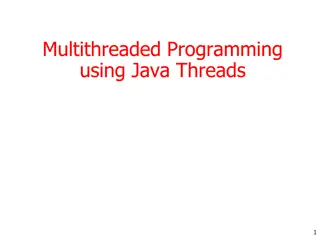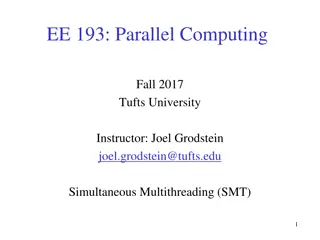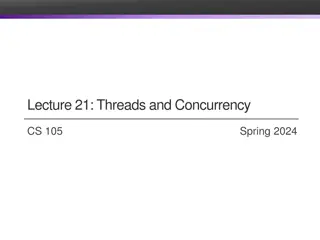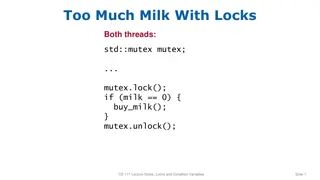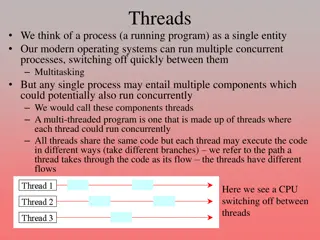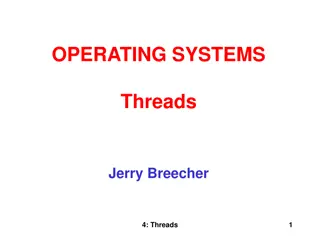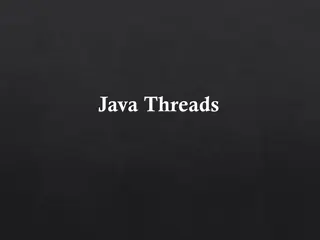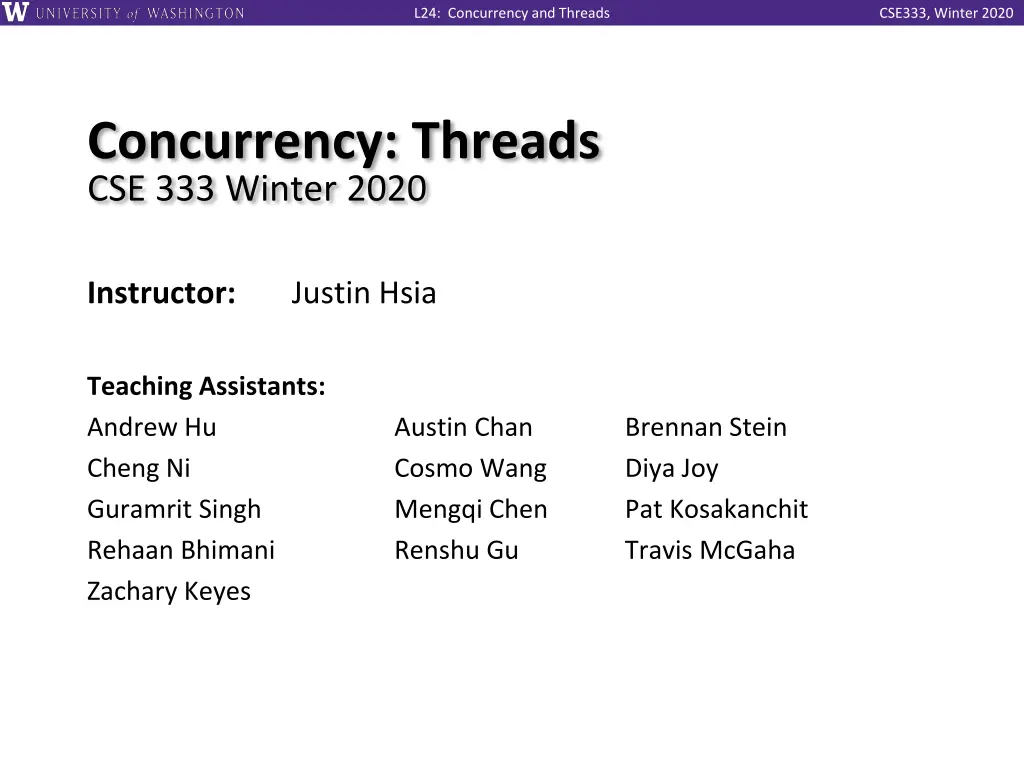
Winter 2020 Concurrency and Threads Overview
Explore the Winter 2020 CSE333 Concurrency and Threads course details, including creating and terminating threads, what to do after forking threads, and a concurrent server with threads. Get insights on assignments, due dates, and resources for the course.
Download Presentation

Please find below an Image/Link to download the presentation.
The content on the website is provided AS IS for your information and personal use only. It may not be sold, licensed, or shared on other websites without obtaining consent from the author. If you encounter any issues during the download, it is possible that the publisher has removed the file from their server.
You are allowed to download the files provided on this website for personal or commercial use, subject to the condition that they are used lawfully. All files are the property of their respective owners.
The content on the website is provided AS IS for your information and personal use only. It may not be sold, licensed, or shared on other websites without obtaining consent from the author.
E N D
Presentation Transcript
L24: Concurrency and Threads CSE333, Winter 2020 Concurrency: Threads CSE 333 Winter 2020 Instructor: Justin Hsia Teaching Assistants: Andrew Hu Cheng Ni Guramrit Singh Rehaan Bhimani Zachary Keyes Austin Chan Cosmo Wang Mengqi Chen Renshu Gu Brennan Stein Diya Joy Pat Kosakanchit Travis McGaha
L24: Concurrency and Threads CSE333, Winter 2020 Administrivia Exercise 17 released today, due Monday (3/9) Concurrency via pthreads hw4 due Thursday (3/12) Submissions accepted until Sunday (3/15) Final is Wednesday (3/18), 12:30 2:20 pm, ARC 147 Review Session: Sunday (3/15), 4 6:30 pm, TBD Two double-sided, handwritten sheets of notes allowed Topic list and past finals on Exams page on website Please fill out the course evaluations for lecture and your section! 2
L24: Concurrency and Threads CSE333, Winter 2020 Creating and Terminating Threads int pthread_create( pthread_t* thread, const pthread_attr_t* attr, void* (*start_routine)(void*), void* arg); Creates a new thread, whose identifier is place in *thread, with attributes *attr (NULL means default attributes) Returns 0 on success and an error number on error (can check against error constants) The new thread runs start_routine(arg) void pthread_exit(void* retval); Equivalent of exit(retval); for a thread instead of a process The thread will automatically exit once it returns from start_routine() 3
L24: Concurrency and Threads CSE333, Winter 2020 What To Do After Forking Threads? int pthread_join(pthread_t thread, void** retval); Waits for the thread specified by thread to terminate The thread equivalent of waitpid() The exit status of the terminated thread is placed in **retval int pthread_detach(pthread_t thread); Mark thread specified by thread as detached it will clean up its resources as soon as it terminates 4
L24: Concurrency and Threads CSE333, Winter 2020 Concurrent Server with Threads A single process handles all of the connections, but a parent thread dispatches (creates) a new thread to handle each connection The child thread handles the new connection and then exits when the connection terminates See searchserver_threads/ for code if curious 5
L24: Concurrency and Threads CSE333, Winter 2020 Multithreaded Server client accept() server 6
L24: Concurrency and Threads CSE333, Winter 2020 Multithreaded Server pthread_detach() client pthread_create() server 7
L24: Concurrency and Threads CSE333, Winter 2020 Multithreaded Server client accept() client server 8
L24: Concurrency and Threads CSE333, Winter 2020 Multithreaded Server client pthread_create() client server 9
L24: Concurrency and Threads CSE333, Winter 2020 Multithreaded Server client client client shared data structures client client client server 10
L24: Concurrency and Threads CSE333, Winter 2020 Thread Examples See cthread.c How do you properly handle memory management? Who allocates and deallocates memory? How long do you want memory to stick around? See pthread.cc More instructions per thread = higher likelihood of interleaving See searchserver_threads/searchserver.cc When calling pthread_create(), start_routine points to a function that takes only one argument (a void*) To pass complex arguments into the thread, create a struct to bundle the necessary data 11
L24: Concurrency and Threads CSE333, Winter 2020 Why Concurrent Threads? Advantages: Almost as simple to code as sequential In fact, most of the code is identical! (but a bit more complicated to dispatch a thread) Concurrent execution with good CPU and network utilization Some overhead, but less than processes Shared-memory communication is possible Disadvantages: Synchronization is complicated Shared fate within a process One rogue thread can hurt you badly 12
L24: Concurrency and Threads CSE333, Winter 2020 Data Races Two memory accesses form a data race if different threads access the same location, and at least one is a write, and they occur one after another Means that the result of a program can vary depending on chance (which thread ran first?) 13
L24: Concurrency and Threads CSE333, Winter 2020 Data Race Example if (!milk) { buy milk } If your fridge has no milk, then go out and buy some more What could go wrong? If you live alone: If you live with a roommate: ! ! 14
L24: Concurrency and Threads CSE333, Winter 2020 Data Race Example if (!note) { if (!milk) { leave note buy milk remove note } } Idea: leave a note! Does this fix the problem? Vote at http://PollEv.com/justinh A. Yes, problem fixed B. No, could end up with no milk C. No, could still buy multiple milk D. We re lost 15
L24: Concurrency and Threads CSE333, Winter 2020 Threads and Data Races Data races might interfere in painful, non-obvious ways, depending on the specifics of the data structure Example: two threads try to read from and write to the same shared memory location Could get correct answer Could accidentally read old value One thread s work could get lost Example: two threads try to push an item onto the head of the linked list at the same time Could get correct answer Could get different ordering of items Could break the data structure! 16
L24: Concurrency and Threads CSE333, Winter 2020 Synchronization Synchronization is the act of preventing two (or more) concurrently running threads from interfering with each other when operating on shared data Need some mechanism to coordinate the threads Let me go first, then you can go Many different coordination mechanisms have been invented (see CSE 451) Goals of synchronization: Liveness ability to execute in a timely manner (informally, something good happens ) Safety avoid unintended interactions with shared data structures (informally, nothing bad happens ) 17
L24: Concurrency and Threads CSE333, Winter 2020 Lock Synchronization Use a Lock to grant access to a critical section so that only one thread can operate there at a time Executed in an uninterruptible (i.e. atomic) manner Pseudocode: Lock Acquire Wait until the lock is free, then take it // non-critical code loop/idle if locked lock.acquire(); // critical section lock.release(); Lock Release Release the lock If other threads are waiting, wake exactly one up to pass lock to // non-critical code 18
L24: Concurrency and Threads CSE333, Winter 2020 Milk Example What is the Critical Section? fridge.lock() if (!milk) { buy milk } fridge.unlock() What if we use a lock on the refrigerator? Probably overkill what if roommate wanted to get eggs? For performance reasons, only put what is necessary in the critical section Only lock the milk But lock all steps that must run uninterrupted (i.e. must run as an atomic unit) milk_lock.lock() if (!milk) { buy milk } milk_lock.unlock() 19
L24: Concurrency and Threads CSE333, Winter 2020 pthreads and Locks Another term for a lock is a mutex ( mutual exclusion ) pthread.h defines datatype pthread_mutex_t pthread_mutex_init() int pthread_mutex_init(pthread_mutex_t* mutex, const pthread_mutexattr_t* attr); Initializes a mutex with specified attributes pthread_mutex_lock() Acquire the lock blocks if already locked int pthread_mutex_lock(pthread_mutex_t* mutex); pthread_mutex_unlock() Releases the lock int pthread_mutex_unlock(pthread_mutex_t* mutex); int pthread_mutex_destroy(pthread_mutex_t* mutex); Uninitializes a mutex clean up when done 20
L24: Concurrency and Threads CSE333, Winter 2020 pthread Mutex Examples See total.cc Data race between threads See total_locking.cc Adding a mutex fixes our data race How does this compare to sequential code? Likely slower only 1 thread can increment at a time, but have to deal with checking the lock and switching between threads One possible fix: each thread increments a local variable and then adds its value (once!) to the shared variable at the end 21
L24: Concurrency and Threads CSE333, Winter 2020 Your Turn! (pthread mutex) Rewrite thread_main from total_locking.cc: It need to be passed an int* with the address of sum_total and an int with the number of times to loop (in that order) Increment a local sum variable NUM times, then add it to sum_total Handle synchronization properly! 22
L24: Concurrency and Threads CSE333, Winter 2020 C++11 Threads C++11 added threads and concurrency to its libraries <thread> thread objects <mutex> locks to handle critical sections <condition_variable> used to block objects until notified to resume <atomic> indivisible, atomic operations <future> asynchronous access to data These might be built on top of <pthread.h>, but also might not be Definitely use in C++11 code if local conventions allow, but pthreads will be around for a long, long time Use pthreads in current exercise 23




